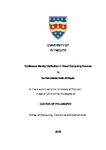Continuous Identity Verification in Cloud Computing Services
| dc.contributor.supervisor | Clarke, Nathan | |
| dc.contributor.author | Al-Bayati, Burhan Mollan Salih | |
| dc.contributor.other | School of Engineering, Computing and Mathematics | en_US |
| dc.date.accessioned | 2018-11-19T17:34:02Z | |
| dc.date.issued | 2018 | |
| dc.identifier | 10505279 | en_US |
| dc.identifier.uri | http://hdl.handle.net/10026.1/12832 | |
| dc.description.abstract |
Cloud computing has become a hugely popular new paradigm for hosting and delivering services over the internet for individuals and organisations with low cost. However, security is a sensitive issue in cloud computing, as it its services remain accessible to anyone after initial authenticated login and for significant periods. This has led to an increase in the number of attacks on sensitive cus-tomer information. This research identified biometric approaches as a possible solution for security to be maintained beyond the point of entry. Specifically, behaviour profiling has been proposed and applied across various other applications in the area of Transparent Authentication Systems (TAS’s) and Intrusion Detection Systems (IDS’s) to detect account misuse. However, little research has sought to imple-ment this technique within cloud computing services to detect misuse. This research proposes a novel continuous identity verification system as a supporting factor to protect cloud users by operating transparently to detect ab-normal access. The research examines the feasibility of applying a behavioural profiling technique on cloud users with respect to Software as a Service (SaaS) and Infrastructure as a Service (IaaS). Two real-life datasets were collected from 30 and 60 users for SaaS and IaaS studies, respectively. A thorough design and investigation of the biometric techniques was undertaken, including description statistics analysis and pattern classification optimisation. A number of factors were analysed to evaluate the impact on system performance, such as volume of data and type of sample selection. On average, using random sampling, the best experimental result achieved an EER (Equal Error Rate) of as low as 5.8%; six users experienced EERs equal to or less than 0.3%. Moreover, the IaaS study achieved a higher performance than the SaaS study with an overall EER of 0.32%. Based on the intensive analysis of the experimental performance of SaaS and IaaS studies, it has been identified that changes in user behaviour over time can negatively affect the performance of the suggested technique. Therefore, a dy-namic template renewal procedure has been proposed as a novel solution to keep recent user behaviour updated in the current users’ templates. The practi-cal experimental result using the more realistic time-series sampling methodolo-gy has shown the validity of the proposed solution with higher accuracy of 5.77 % EER. | en_US |
| dc.language.iso | en | |
| dc.publisher | University of Plymouth | |
| dc.subject.classification | PhD | en_US |
| dc.title | Continuous Identity Verification in Cloud Computing Services | en_US |
| dc.type | Thesis | |
| plymouth.version | publishable | en_US |
| dc.identifier.doi | http://dx.doi.org/10.24382/534 | |
| dc.rights.embargodate | 2019-11-19T17:34:02Z | |
| dc.rights.embargoperiod | 12 months | en_US |
| dc.type.qualification | Doctorate | en_US |
| rioxxterms.version | NA |
Files in this item
This item appears in the following Collection(s)
-
01 Research Theses Main Collection
Research Theses Main


